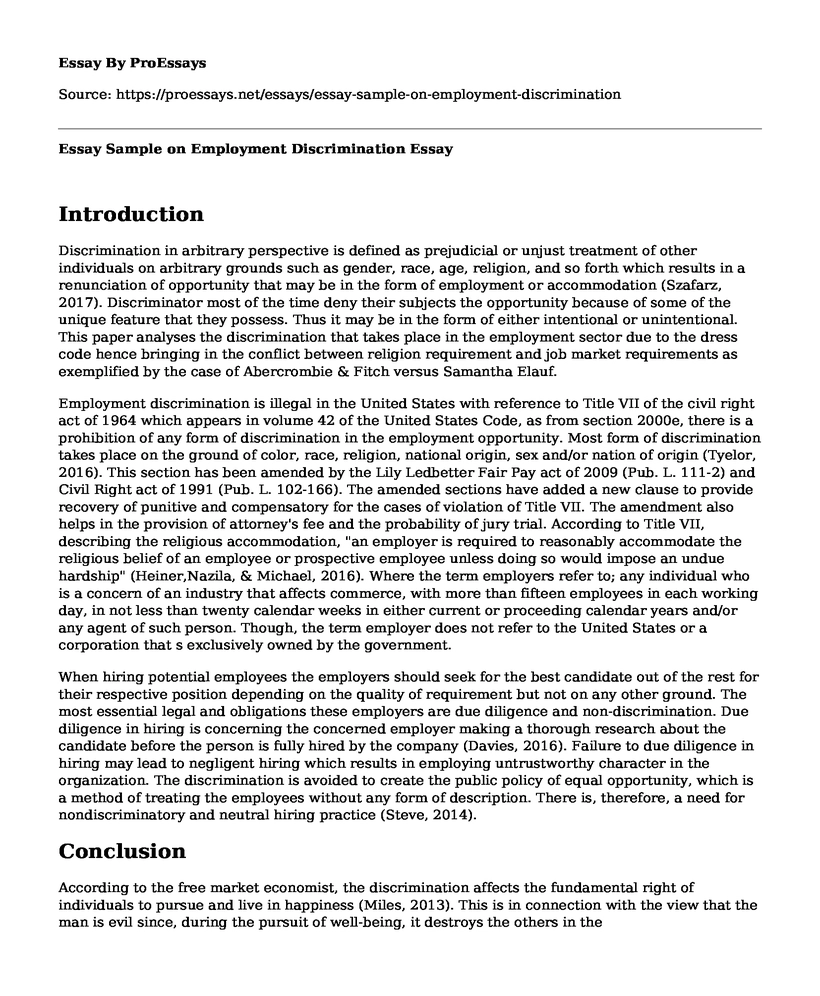Introduction
Discrimination in arbitrary perspective is defined as prejudicial or unjust treatment of other individuals on arbitrary grounds such as gender, race, age, religion, and so forth which results in a renunciation of opportunity that may be in the form of employment or accommodation (Szafarz, 2017). Discriminator most of the time deny their subjects the opportunity because of some of the unique feature that they possess. Thus it may be in the form of either intentional or unintentional. This paper analyses the discrimination that takes place in the employment sector due to the dress code hence bringing in the conflict between religion requirement and job market requirements as exemplified by the case of Abercrombie & Fitch versus Samantha Elauf.
Employment discrimination is illegal in the United States with reference to Title VII of the civil right act of 1964 which appears in volume 42 of the United States Code, as from section 2000e, there is a prohibition of any form of discrimination in the employment opportunity. Most form of discrimination takes place on the ground of color, race, religion, national origin, sex and/or nation of origin (Tyelor, 2016). This section has been amended by the Lily Ledbetter Fair Pay act of 2009 (Pub. L. 111-2) and Civil Right act of 1991 (Pub. L. 102-166). The amended sections have added a new clause to provide recovery of punitive and compensatory for the cases of violation of Title VII. The amendment also helps in the provision of attorney's fee and the probability of jury trial. According to Title VII, describing the religious accommodation, "an employer is required to reasonably accommodate the religious belief of an employee or prospective employee unless doing so would impose an undue hardship" (Heiner,Nazila, & Michael, 2016). Where the term employers refer to; any individual who is a concern of an industry that affects commerce, with more than fifteen employees in each working day, in not less than twenty calendar weeks in either current or proceeding calendar years and/or any agent of such person. Though, the term employer does not refer to the United States or a corporation that s exclusively owned by the government.
When hiring potential employees the employers should seek for the best candidate out of the rest for their respective position depending on the quality of requirement but not on any other ground. The most essential legal and obligations these employers are due diligence and non-discrimination. Due diligence in hiring is concerning the concerned employer making a thorough research about the candidate before the person is fully hired by the company (Davies, 2016). Failure to due diligence in hiring may lead to negligent hiring which results in employing untrustworthy character in the organization. The discrimination is avoided to create the public policy of equal opportunity, which is a method of treating the employees without any form of description. There is, therefore, a need for nondiscriminatory and neutral hiring practice (Steve, 2014).
Conclusion
According to the free market economist, the discrimination affects the fundamental right of individuals to pursue and live in happiness (Miles, 2013). This is in connection with the view that the man is evil since, during the pursuit of well-being, it destroys the others in the environment.Although the American constitution prohibits the discrimination when it comes to employment, some organizations still practice this act and if action is not taken, the disadvantaged will not have a place of earning a living.
References
Davies, G. (2016). Between market access and discrimination: free movement as a right to fair conditions of competition. Research Handbook on the Law of the US Internal Market, 2(3), 13-28.
Heiner, Prof, B., Nazila, Dr, G., & Michael, Dr, W. (2016). Part 2 Discrimination, 2.1 Discrimination on the Basis of Religion or Belief/Interreligious Discrimination/Tolerance. Freedom of Religion or Belief, 09(8), 78-79.
Miles, K. (2013). Soft Law Instruments in Environmental Law: Models for International Investment Law? International Investment Law and Soft Law, 12(3), 56-59.
Steve J. (2014). Need for Best Practice in Hiring.Neutrality in Hiring, 2(9), 1-4.
Szafarz, A. (2017). Hiring People-Like-Yourself: A Representation of Discrimination on the Job Market.SSRN Electronic Journal, 2(6), 34.
Tyelor Y. (2016). Protecting Individuals from Discrimination.Employment Relations in the United States: Law, Policy, and Practice Employment relations in the United States: Law, policy, and practice, 23(34), 181-214.
Cite this page
Essay Sample on Employment Discrimination. (2022, May 16). Retrieved from https://proessays.net/essays/essay-sample-on-employment-discrimination
If you are the original author of this essay and no longer wish to have it published on the ProEssays website, please click below to request its removal:
- Literature Review Example on Childhood Obesity in the United States
- Research Paper on Economic and Social Impacts of the Terror Attacks in France
- Impact of the Media on Child Abuse and Neglect Essay
- Research Paper on End Human Trafficking: 2nd Largest Criminal Activity Worldwide
- Women, Guns and Personal Safety: Essay Sample on Linda Hasselstrom's Debate
- Paper Sample: Athletes Unite for Social Justice Awareness
- Globalization and Its Consequences - Free Essay Example







